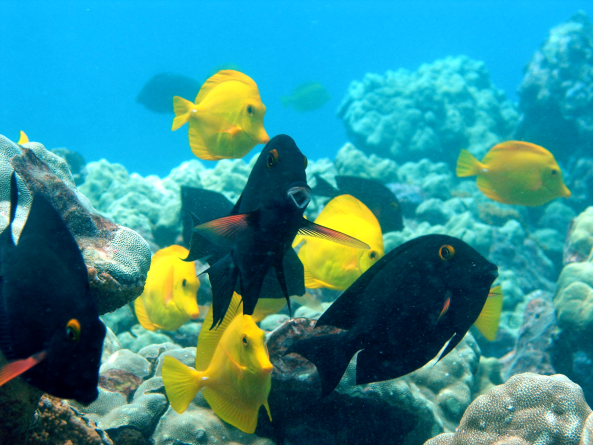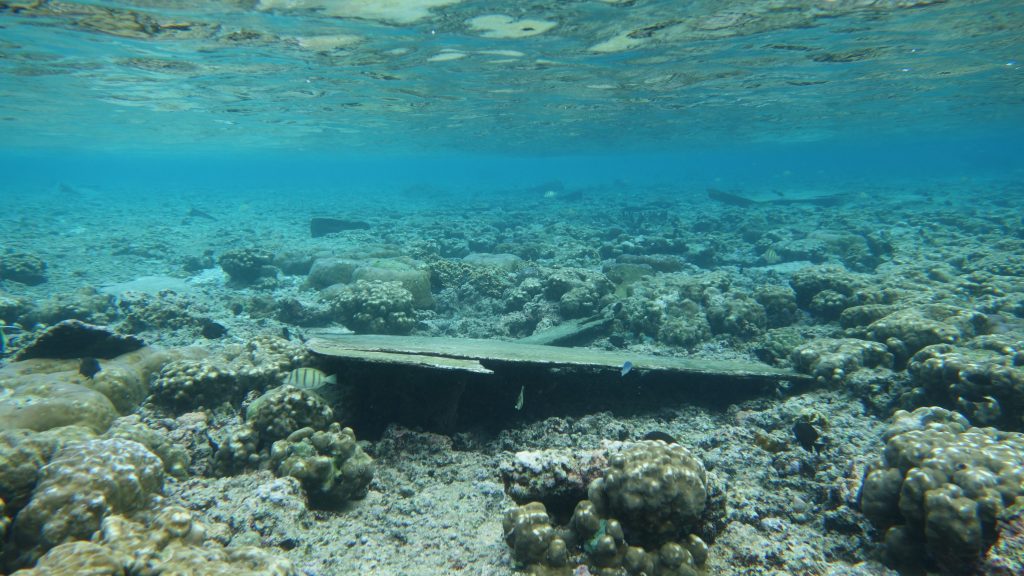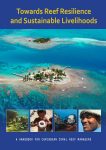Management Recommendations
Below are recommendations for managers to conduct resilience-based management based on Mcleod et al. 2019: ref
1. Protect a diversity and redundancy of species, habitats, and functional groups
Protecting and maintaining diversity can improve resilience, as different species and habitats support different ecological processes, reducing the risk for catastrophic changes in reef state.ref Diversity includes both ecological and social aspects, such as diversity of livelihood strategies and governance systems. Many complexities exist with each aspect of diversity. For example, promoting coral species diversity may reduce overall reef resilience by increasing the number of stress-sensitive corals, and herbivores' importance with controlling macroalgae vary depending on the region. To apply RBM most effectively, research is needed to clarify how different types of diversity promote ecosystem functioning and reef recovery. General guidance on protecting coral reef diversity (e.g., Green and Bellwood 2009)ref can be used until more detailed information is available.

Beneficial herbivorous fishes fully protected within the Kahekili Herbivore Fishery Management Area in Hawai‘i. Photo © Hawai‘i DLNR
2. Maintain pathways of connectivity
Connectivity can promote reef recovery by providing a supply of coral larvae from less impacted reefs, reseeding other reefs within range. Connections between reefs and adjacent seagrass and mangrove habitats can also be important for reef health and recovery. The role of connectivity in supporting recovery depends on local conditions and oceanographic factors affecting larval transport. It is recommended to prioritize high connectivity reefs within Marine Protected Areas (MPAs) and pair this information where possible with data on climate change/bleaching exposure. A commonly used method to identify connectivity is a high-resolution coral larval dispersal simulation. Where data are not available, general principles for incorporating connectivity into MPA design should be used.ref
3. Reduce local stressors to support reef resistance and recovery
Studies suggest that reducing local threats can, in some cases, support reef recovery following disturbance and may support resistant coral assemblages.ref For instance, nutrient pollution, sedimentation, and physical impacts can reduce coral growth rates, increase algal growth, and increase the incidence of coral disease and bleaching. While local management actions may provide some reefs with improved capacity to cope with climate impacts, they are not able to prevent reefs from succumbing to extreme climate impacts.ref However, efforts to control local and regional stressors should continue as part of a broader suite of management actions that includes climate change mitigation efforts.

Boat damage on a reef. Photo © Alice Lawrence/American Samoa Department of Marine and Wildlife Resources
4. Implement MPAs to support reef resilience including the protection of refuges
MPAs are a core strategy for RBM and an important tool to support reef resilience. MPAs can help to reduce local stressors, restore coral reef food webs, support herbivory, and promote recovery. However, most MPAs across the globe have not been designed to consider climate change impacts, for instance by including temperature refugia or networks that support increased larval supply. To be effective for RBM, MPAs should be designed to manage local stressors; include the full suite of habitat types to promote diversity and functional redundancy; ensure connectivity between healthy and degraded reefs to support larval supply; include coral refuges; and incorporate a variety of thermal regimes to capture diverse coral assemblages. Where possible, MPA designs should incorporate local community knowledge and engagement.
5. Manage adaptively to accommodate uncertainty and change
A core element of RBM is adapting to environmental changes that are anticipated under a changing climate. Key components of adaptive management include 1) monitoring and evaluation; 2) a continuing cycle of experimentation and reevaluation; 3) participatory approaches; and 4) diverse stakeholder participation.ref Barriers to conducting adaptive management include difficulty embracing uncertainty; institutional barriers; high monitoring costs; limited ability to model the effects of complex ecological systems on humans and policy; constraints of experimental designs; lack of use of models to screen management policies; conflicting opinions and objectives of stakeholders; and self-serving behavior of scientists or managers.ref A special issue of papers addressing these barriers are summarized in Keith et al. 2011.ref
6. Prioritize areas with low environmental risk and high social adaptive capacity
When prioritizing areas for RBM, managers should consider social, ecological, and/or economic objectives, the risks and benefits, feasibility of management success, and what trade-offs are considered acceptable. It is suggested to prioritize areas with low environmental risk, although prioritizing areas with high environmental risk may also be warranted. Areas with high social adaptive capacity should be prioritized regardless, as communities must be able and willing to comply with protection measures in order for conservation actions to be successful. Several types of tools have been developed for decision-making of management strategies, such as scenario planning and decision analysis, which could be used to help managers with a structured process to identify and prioritize areas based on potential future conditions.
7. Incorporate social and ecological indicators to assess early warnings, recovery patterns, and regime shifts in conservation planning and monitoring
Incorporating resilience into conservation planning should include monitoring both ecological and social resilience indicators. For ecological indicators, monitoring programs should focus on metrics that assess recruitment and recovery patterns rather than only including static measures of reef state (e.g., coral cover, fish abundance), which can be poor indicators of resilience.ref Social indicators may include fishing technologies, markets, demographic changes, and changes in governance structures or policy.ref Combining projected future exposure with data on resilience indicators can help managers to map relative vulnerability to climate change and prioritize RBM actions.
8. Explore experimental approaches to support resilience
For coral reefs to thrive under projected climate change scenarios, new interventions supporting all levels of reef resilience (e.g., genetic, habitat, ecosystem) will need to be incorporated into RBM.ref New research has identified several emerging interventions, such as managed selection and breeding, gamete and larval capture and seeding, coral cryopreservation, genetic manipulation, managed relocation, and reef shading. ref It is recommended that local management agencies engage with research facilities, as local managers can provide information on local social-ecological context and input on methodologies for scaling up successful trials.

Collecting coral spawn to fertilize and grow corals for restoration. Photo © Paul Selvaggio
9. Implement strategies to build social and ecological adaptive capacity
Adaptive capacity is the ability of systems, institutions, humans, and other organisms to adjust to potential damage, take advantage of opportunities, or respond to consequences.ref A newer priority of RBM is implementing strategies that build social adaptive capacity, as communities with increased capacity may be better able to cope with restrictions on resource use.ref Strategies should seek to empower local communities to prepare for and adapt to changes in reef resource use or condition,ref and may include: supporting economic diversity and alternative livelihood opportunities; strengthening social networks and sharing resources between reef users; and supporting traditional knowledge and co-management of resources. ref

Women with juvenile sea cucumbers at pilot study, Andavadoaka. Photo © Garth Cripps/Blue Ventures
10. Implement strategies to facilitate adaptation and transformation
RBM calls for managers to support adaptation and transformation. For ecological systems, this may include instituting buffer zones around protected areas to include the potential for species to adapt and move under future climate change conditions. Supporting polycentric governance systems, characterized by multiple governing authorities that function independently but seek to achieve shared goals. This type of governance may help social systems adapt and transform as they can provide opportunities for learning, broaden participation in governance, and encourage local knowledge sharing across scales.ref If prepared for, large-scale changes can be used to trigger transformation actions such as re-zoning or altered fisheries governance.ref
Resource Spotlight:
 Towards Reef Resilience and Sustainable Livelihoods. This handbook for reef managers outlines topics critical to the future of Caribbean reefs (i.e. resilience, climate change, fisheries, ecosystem services, governance, livelihoods, and monitoring) and provides policy and management recommendations.
Towards Reef Resilience and Sustainable Livelihoods. This handbook for reef managers outlines topics critical to the future of Caribbean reefs (i.e. resilience, climate change, fisheries, ecosystem services, governance, livelihoods, and monitoring) and provides policy and management recommendations.

Resources
Interpreting Coral Reef Monitoring Data: A Guide for Improved Management Decisions
The Future of Resilience-based Management in Coral Reef Ecosystem
A Research Review of Interventions to Increase the Persistence and Resilience of Coral Reefs
A Decision Framework for Interventions to Increase the Persistence and Resilience of Coral Reefs